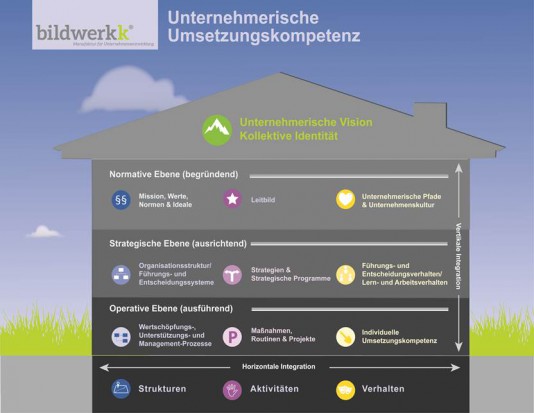 Jochen Schuchardt, bildwerkk, about experiences and concepts for managing gaps between knowledge, decisions and solution implementations.
Jochen Schuchardt, bildwerkk, about experiences and concepts for managing gaps between knowledge, decisions and solution implementations.
1. Mr. Schuchardt, what does „Crossing the Knowing Doing Gap“ mean and for whom is this interesting?
Peter F. Drucker once said: “What all successful people have in common is the ability to keep the gap between decision and execution extremely narrow.” This quote describes quite well what we mean by “Crossing the Knowing Doing Gap”. We see gaps between the knowledge, the decision and the implementation. Otherwise it’s hard to explain that 50% of all strategy implementations fail or that 70% of all change projects cannot fulfill the expectations.
We believe that “Crossing the Knowing Doing Gap” is interesting, for all who want to implement changes and execute projects effectively, instead investing their time and budgets in depth analysis and huge management presentations.
2. When and how did you come up with the idea to develop a method for the practice about the discrepancy between the existing and applied knowledge?
For nearly 20 years we advise companies in organizational and technological change projects. Trends, strategies and innovations come and go. But one turns out as the real challenges, the integration of the change in the company and getting the “buy-in” of all stakeholders. According to our made experiences the timeless core questions are:
• How do we get the change implemented to get the intended effect?
• How do we achieve the desired sustainability of the change?
• How will the change be positively for the people and not only documented on paper?
If we have a look into our project portfolio the focus of our work so far has always been on these timeless core questions and to the overcoming of Knowing Doing Gaps. Even if no one has so called it in the last few years. Here we see actually the key success factor for managing changes and projects effectively. Exactly this is our motivation to develop and to operationalize this topic and method.
3. Ideally, companies have planned their strategies and objectives and specified in projects. How do you identify “Knowing Doing Gap” during the strategy planning and strategy transformation processes?
This is indeed the ideal case. Projects and measures are derived and implemented from strategies and objectives. But in practice, this last step of transformation is too often inconsistently managed:
 We see that Knowing Doing Gaps occurs where the so-called horizontal and/or vertical integration was not consciously designed.
We see that Knowing Doing Gaps occurs where the so-called horizontal and/or vertical integration was not consciously designed.
What do you mean?
Based on the St. Gallen management model we have designed a so-called «House of entrepreneurial implementation competence», which is structured in three respectively in four substantially vertical levels:
Besides a normative level, there are in every company a derived strategic and an operational level. And these three levels are ideally aligned to a common business vision or collective identity. Beyond that, horizontal structures have to be created on each level, that support specific activities or rather the actual value. In turn these activities are owned by people with their behavior and their individual implementation competence.
Knowing Doing Gap arise in our opinion always where the structures, activities and behavior simply do not mesh (horizontal integration) and where a connection between parent and child level (vertical integration) is missing. So if no strategies with relevant projects can be derived from a mission Knowing Doing Gaps will arise. In the same manner e.g. like management principles, which are thwarted by the executives in their actions. And to give a further example: even sale strategies, that are unsupported by the processes and IT systems, lead to deep Knowing Doing Gaps.
The identification of Knowing Doing Gaps is usually not an easy task, because the reasons of gaps can be found on all levels of a company. Therefore a systemic view to the “system company” has turned out to be helpful.
4. What are the key points and what are the challenges in order to avoid KDGs?
In addition to the holistic view of the company another focus is relevant to identify and overcome Knowing Doing Gaps. As we understand business the implementation competence and the individual one of each employee are closely linked. Therefore it can be beneficial to take a common view with the staff on this field of competences when it comes to the point to turn knowledge and decision into successful action.
Within the individual implementation competences the following fundamental questions are relevant: Does the individual value system matches to that of the company? In case there is a significant deviation, people will not get involved in the interests of the company. In addition the subject of self-control is also very important. Are the people in the company capable implementing motives and goals into actions, even if they have a conflict with their own motives to a certain degree? This is from time to time necessary to achieve the necessary results. These individual implementation competences can be enhanced through training, coaching and goog practices transferred from colleagues. This is basically an important step towards crossing Knowing Doing Gaps.
5. Are there differences in the procedure to identify “Knowing Doing Gaps” at the strategic, tactical and operational level?
Basically the approach and the method to identify Knowing Doing Gaps are independent of the level. However we see differences between involved stakeholders and in the interaction with these stakeholders. Typically we start with our work top-down and bottom-up in order to bring together all stakeholders of each level to push the Knowing Doing Gap identification and resolution.
Of course, there is an essential point to address when Knowing Doing Gaps will be identified and resolved: the encouragement of stakeholders especially on the operational level. Do show and prove that their impressions, suggestions and intuitions do matter.
6. While at the operational level mainly the Doing takes place, much knowledge will be created continuously. Which mechanisms do you recommend to consider bottom-up the knowledge of the operational level in the company objectives and strategies?
According to our understanding reflected in the “House of entrepreneurial implementation competence”, knowledge will be created on all levels from the interactions of structures, activities and behavior. And in fact it is a huge challenge to consider the knowledge flow from the operational level into the strategic level (normative level). To ensure the return and especially the effectiveness of knowledge on all levels, the corporate culture plays an essential role. Here we can also see very specific dialogue-oriented measures in small and large groups as essential instruments which should be used on a regular basis.
7. Over the last years the market dynamics have been increasing constantly in various industries resulting in more complexity within the company. Do you see increasing complexity as a driver for “Knowing Doing Gaps”? What are typical drivers in the practice?
We also see that the complexity increases in all industries, in all subjects, for all sizes of companies. Often corporate structures, tasks and behavior are not yet ready for the dynamics and just re-act on change pressure. In doing so we regular notice that the individual levels and areas of actions have various development stages in companies. From our point of view the main drivers for Knowing Doing Gaps are the missing integration performance by management, the neglecting of individual implementation competence and finally a lack of connectivity between individuals and company.
8. So far we have talked about the identification of “Knowing Doing Gaps”. What solutions have been proven in practice to reduce or to eliminate gaps to ensure the “Crossing”?
The reduction of existing KDGs or the prevention of future KDGs has a lot to do with leadership, communication and culture. It seems to us important from a structural point of view to anchor experience and seniority with an entrepreneurial curiosity among the employees on all company levels. That means to combine the advantages of the family business with a start-up company. Making powerful decisions and ensuring room for curiosity and innovations. However especially the decision-making and decision enforcement are important factors against KDGs. But also communication rules, sometimes quite trivial communication rules, are effective solutions for crossing Knowing Doing Gaps directly. No meeting without any agreed actions that will be tracked. No decision without documentation and communication. What appears as pure formalism in the beginning can also be designed very much alive in practice through appropriate visualization or by the use of social media.
Finally, the complexity reduction in the “business language” and strengthening the clear and transparent communication are additional solutions against Knowing Doing Gaps.
9. How do you deal with a “Knowing Gap”, which the company is not aware of?
How does a doctor deal with it, when a patient does not accept the diagnosis and the therapy proposal? Quite often a patient contacts further doctors or asks friends or the internet to confirm or to disprove the statements of the doctor. A similar approach do we use in companies. It is essential to involve key stakeholders with their opinions and views.
In our mentioned doctor example does mean, that if a patient still does not want to accept the problem after obtaining other opinions, you cannot convince him with the best arguments. The same situation can be transferred to practice within companies. Either decision-makers are aware about having Knowing Doing Gaps or even a “Knowing Gap” and they are willing to do anything for resolving it or not. And if they do not want to recognize a Knowing Doing Gap, then that decision needs to be accepted. In that case a self-critical view on the own work as an external consultant can be helpful. Because push back or resistance can be an indication that the own acting has been too fast or maybe it has been overlooked something important.
10. What is your outlook regarding demand and integration of mobilization and change management in the market for the next couple of years?
If we look at Amazon for example nearly 4,000 German and more than 7,000 foreign titles on the subject of change management can be found today. A clear indication for us that change management has a huge demand and interests already in the market. This will certainly go on like this getting more and more a core competence on company level as already widely established for project management. “How can companies integrate and anchor changes without losing power while fighting with the complexity of the implementation as well as the lifecycle of strategies will become shorter and shorter?” This question is key that all companies have to face, and as a conclusion we think that change management and mobilization will further be on the agenda of the most companies.
